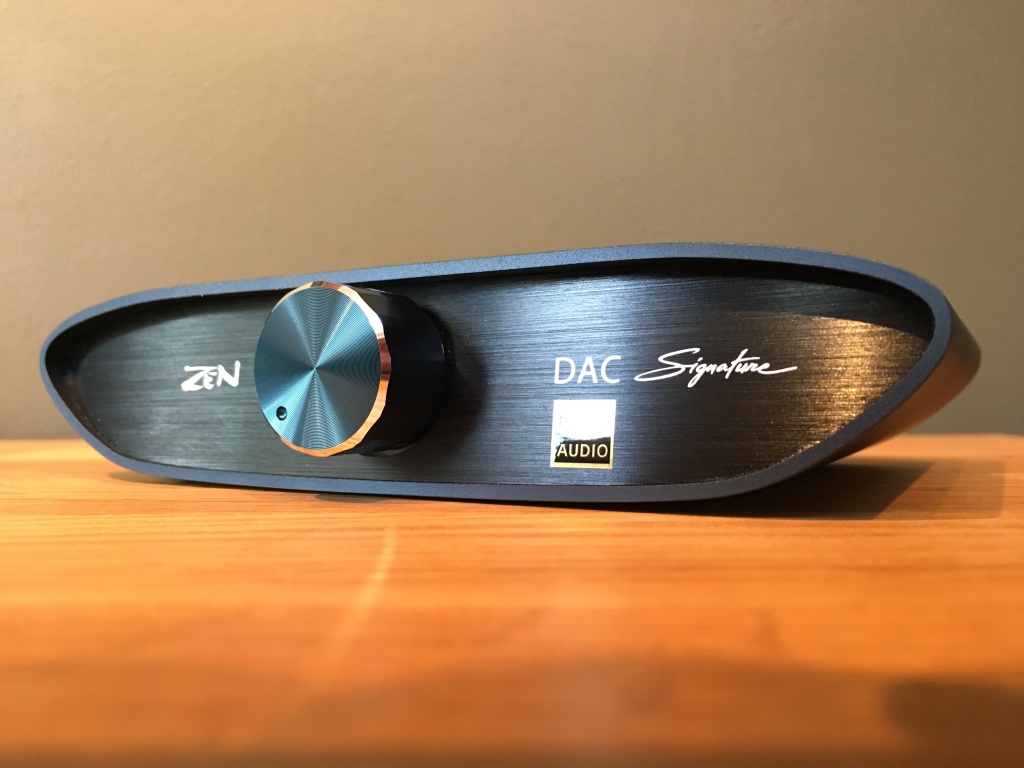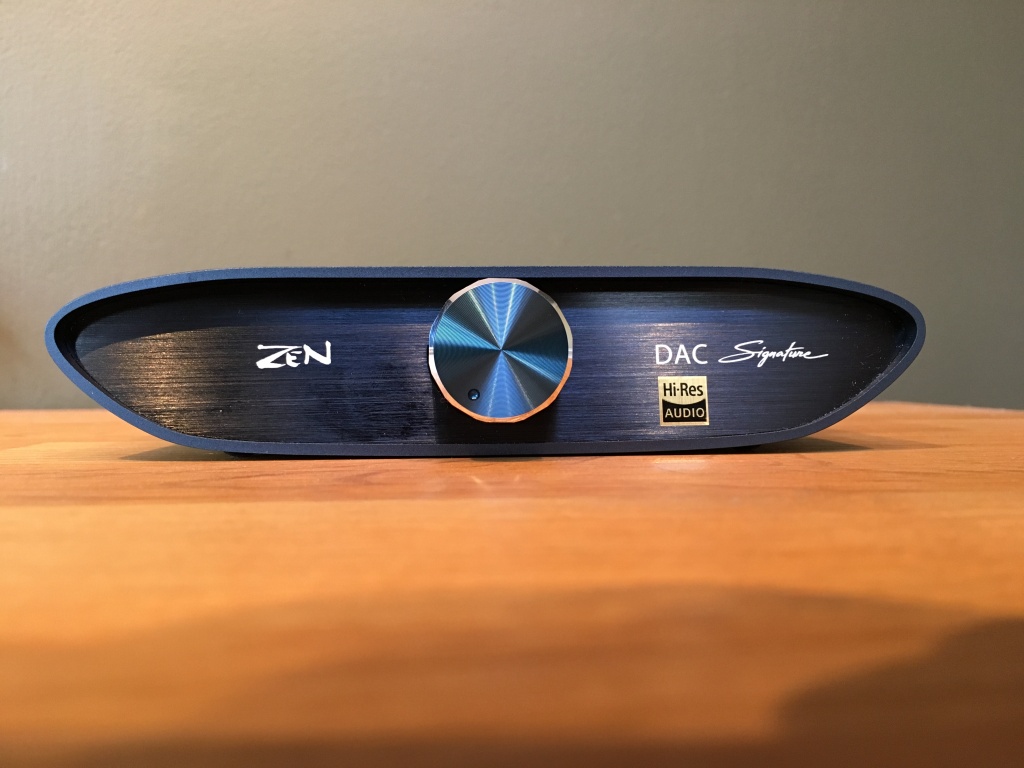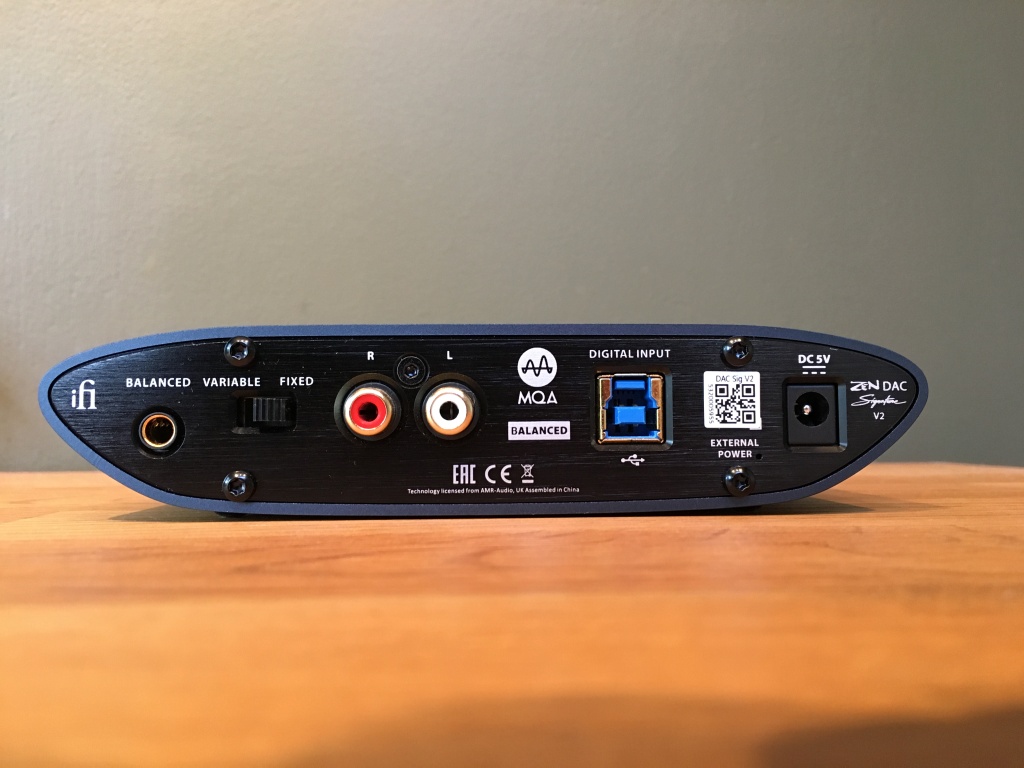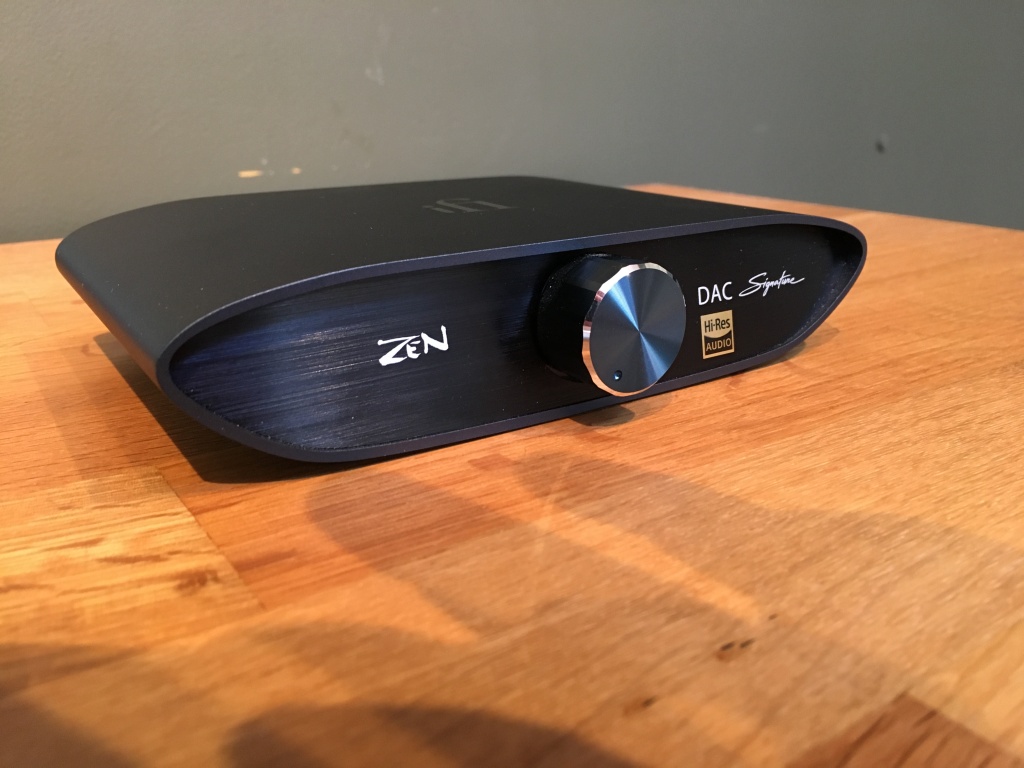General Information
Be at one with your music with ZEN DAC
Highly specified, super-affordable and simple to use, iFi’s ZEN DAC elevates your digital audio experience to a higher plane
Southport, England – Hot on the heels of the ZEN Blue hi-res Bluetooth streamer, iFi expands the ZEN family of desktop-sized audio products with the ZEN DAC – a USB DAC/headphone amp offering a level of specification and performance that belies its eminently affordable £129 price tag.

Designed for home use – on a desk, perhaps, or in the living room – the ZEN DAC connects to PCs and Macs, or smart devices such as tablets or phones, via USB. Its hi-res digital-to-analogue conversation technology processes all forms of digital audio to a super-high standard, while the integrated analogue headphone amplifier delivers superb sound with all headphone types, from in-ear monitors to larger on- and over-ear designs.
Compared to simply plugging headphones directly into a computer or smart device, the ZEN DAC transforms the listening experience – sound is clearer, more detailed, more expansive and engaging, making the most of whichever headphones are connected.
As well as driving headphones, the ZEN DAC can be used as a USB DAC in a home audio system, with or without its volume control engaged. What’s more, whether you’re hooking up headphones, an external amp or active speakers, you have a choice of single-ended or balanced connection – a remarkable facility at the price.
Digital stage
The DAC section is based around a Burr-Brown DAC chip that iFi uses extensively, selected for its fluid, highly ‘musical’ sound quality and ‘True Native’ architecture. This, together with the XMOS chip used for input processing, enables iFi to deliver excellent sound quality across all manner of digital audio formats including hi-res PCM, ‘bit-perfect’ DSD and MQA *– the hi-res streaming codec, as used by Tidal’s ‘Masters’ tier. Given the diminutive asking price, the ZEN DAC’s digital audio credentials are highly impressive.
PCM and DXD audio data is supported up to 24-bit/384kHz, alongside DSD sampling rates from 2.8MHz to 12.4MHz (DSD256). Thanks to the Burr-Brown chip’s True Native design, PCM and DSD take separate pathways – this enables DSD to remain ‘bit-perfect’ in its native form, right through to analogue conversion. Many DACs that claim DSD compatibility accept DSD data but then convert it to PCM; for DSD purists, the ZEN DAC is a fantastic affordable solution.

Another circuit feature that separates this and other DACs made by iFi from competing designs is iFi’s in-house programming of the XMOS chip. While other manufacturers simply use the firmware that comes with the chip off-the-shelf, which is not typically optimised for audiophile-grade sound, iFi programs its own bespoke firmware to boost audio processing power.
iFi’s continuous software development allows features to be added or optimised via firmware updates, enabling the ZEN DAC to be tailored to the user’s playback priorities and ensuring it stays cutting-edge over time. Users can even download and install different versions of iFi firmware to experiment with different digital filters should they so desire.
Extensive clock-locking is used throughout the digital stage to eradicate jitter, maintaining the integrity of the digital signal until conversion.
Analogue stage
The ZEN DAC’s analogue stage is a balanced design – highly unusual in a DAC/headphone amp anywhere near this price point. It incorporates a range of high-quality circuit components, carefully selected for their performance in an audio context, including C0G capacitors from TDK, a precision low-noise power supply IC from Texas Instruments and a high-quality analogue volume pot.
The headphone amp stage has switchable gain, which iFi terms PowerMatch. This matches the level of drive to the load presented by the headphones, by adjusting input sensitivity and thereby signal strength. With high-sensitivity headphone types such as in-ear monitors, leave PowerMatch at its lower setting for ultra-low-noise performance. But if your headphones require more drive – most on/over-ear types, for example – press the PowerMatch button on the front panel to increase gain.
TrueBass is another user-selectable feature. An evolution of iFi’s established XBass circuit, TrueBass is a sophisticated form of ‘bass boost’ that subtly enhances low frequencies without muddying the midrange – particularly useful with earphones and open-back headphones that may lack deep bass. It operates entirely in the analogue domain rather than messing with the digital signal via DSP and may be switched in or out via another button on the front panel.
Well connected
The ZEN DAC sports Pentaconn 4.4mm balanced outputs, both front and back – this is a relatively new interface type, designed to enable balanced signal transfer between compact products that cannot accommodate traditional XLR connections. The front-mounted 4.4mm output sits alongside a standard, single-ended 6.3mm headphone socket – thus, the benefits of balanced headphone designs are fully utilised, whilst also accommodating every type of headphone, both balanced and single-ended.

The 4.4mm output to the rear enables connection to amps and active speakers equipped with a balanced input – either a Pentaconn 4.4mm input, or XLR inputs via a 4.4mm-to-XLR cable. Single-ended RCA outputs are also provided.
These line-level outputs – both balanced and single-ended – can be switched between ‘variable’ and ‘fixed’, enhancing the ZEN DAC’s versatility. The variable setting applies volume control to the audio signal, enabling the ZEN DAC to perform as a preamp feeding a power amp or active speakers. The fixed option bypasses the volume control, fixing the output at 4.2V (balanced) or 2.1V (single-ended) for connection to an external preamp or integrated amp.
The ZEN DAC’s asynchronous USB Type B input supports the ‘SuperSpeed’ USB 3.0 standard and is also compatible with USB 2.0.
In common with other ZEN Series products, the ZEN DAC sports a sturdy, smartly finished aluminium enclosure, neatly sized at 158x35x100mm (WxHxD). Even the rotary volume control is aluminium, giving a reassuringly solid feel – impressive at the product’s super-affordable price. Behind the volume control resides an LED that changes colour to indicate the sampling rate of the audio data received.
The iFi ZEN DAC is available from mid-October, at an RRP of £129. Further ZEN Series products are set to follow in the coming months.

Highly specified, super-affordable and simple to use, iFi’s ZEN DAC elevates your digital audio experience to a higher plane
Southport, England – Hot on the heels of the ZEN Blue hi-res Bluetooth streamer, iFi expands the ZEN family of desktop-sized audio products with the ZEN DAC – a USB DAC/headphone amp offering a level of specification and performance that belies its eminently affordable £129 price tag.
Designed for home use – on a desk, perhaps, or in the living room – the ZEN DAC connects to PCs and Macs, or smart devices such as tablets or phones, via USB. Its hi-res digital-to-analogue conversation technology processes all forms of digital audio to a super-high standard, while the integrated analogue headphone amplifier delivers superb sound with all headphone types, from in-ear monitors to larger on- and over-ear designs.
Compared to simply plugging headphones directly into a computer or smart device, the ZEN DAC transforms the listening experience – sound is clearer, more detailed, more expansive and engaging, making the most of whichever headphones are connected.
As well as driving headphones, the ZEN DAC can be used as a USB DAC in a home audio system, with or without its volume control engaged. What’s more, whether you’re hooking up headphones, an external amp or active speakers, you have a choice of single-ended or balanced connection – a remarkable facility at the price.
Digital stage
The DAC section is based around a Burr-Brown DAC chip that iFi uses extensively, selected for its fluid, highly ‘musical’ sound quality and ‘True Native’ architecture. This, together with the XMOS chip used for input processing, enables iFi to deliver excellent sound quality across all manner of digital audio formats including hi-res PCM, ‘bit-perfect’ DSD and MQA *– the hi-res streaming codec, as used by Tidal’s ‘Masters’ tier. Given the diminutive asking price, the ZEN DAC’s digital audio credentials are highly impressive.
PCM and DXD audio data is supported up to 24-bit/384kHz, alongside DSD sampling rates from 2.8MHz to 12.4MHz (DSD256). Thanks to the Burr-Brown chip’s True Native design, PCM and DSD take separate pathways – this enables DSD to remain ‘bit-perfect’ in its native form, right through to analogue conversion. Many DACs that claim DSD compatibility accept DSD data but then convert it to PCM; for DSD purists, the ZEN DAC is a fantastic affordable solution.
Another circuit feature that separates this and other DACs made by iFi from competing designs is iFi’s in-house programming of the XMOS chip. While other manufacturers simply use the firmware that comes with the chip off-the-shelf, which is not typically optimised for audiophile-grade sound, iFi programs its own bespoke firmware to boost audio processing power.
iFi’s continuous software development allows features to be added or optimised via firmware updates, enabling the ZEN DAC to be tailored to the user’s playback priorities and ensuring it stays cutting-edge over time. Users can even download and install different versions of iFi firmware to experiment with different digital filters should they so desire.
Extensive clock-locking is used throughout the digital stage to eradicate jitter, maintaining the integrity of the digital signal until conversion.
Analogue stage
The ZEN DAC’s analogue stage is a balanced design – highly unusual in a DAC/headphone amp anywhere near this price point. It incorporates a range of high-quality circuit components, carefully selected for their performance in an audio context, including C0G capacitors from TDK, a precision low-noise power supply IC from Texas Instruments and a high-quality analogue volume pot.
The headphone amp stage has switchable gain, which iFi terms PowerMatch. This matches the level of drive to the load presented by the headphones, by adjusting input sensitivity and thereby signal strength. With high-sensitivity headphone types such as in-ear monitors, leave PowerMatch at its lower setting for ultra-low-noise performance. But if your headphones require more drive – most on/over-ear types, for example – press the PowerMatch button on the front panel to increase gain.
TrueBass is another user-selectable feature. An evolution of iFi’s established XBass circuit, TrueBass is a sophisticated form of ‘bass boost’ that subtly enhances low frequencies without muddying the midrange – particularly useful with earphones and open-back headphones that may lack deep bass. It operates entirely in the analogue domain rather than messing with the digital signal via DSP and may be switched in or out via another button on the front panel.
Well connected
The ZEN DAC sports Pentaconn 4.4mm balanced outputs, both front and back – this is a relatively new interface type, designed to enable balanced signal transfer between compact products that cannot accommodate traditional XLR connections. The front-mounted 4.4mm output sits alongside a standard, single-ended 6.3mm headphone socket – thus, the benefits of balanced headphone designs are fully utilised, whilst also accommodating every type of headphone, both balanced and single-ended.
The 4.4mm output to the rear enables connection to amps and active speakers equipped with a balanced input – either a Pentaconn 4.4mm input, or XLR inputs via a 4.4mm-to-XLR cable. Single-ended RCA outputs are also provided.
These line-level outputs – both balanced and single-ended – can be switched between ‘variable’ and ‘fixed’, enhancing the ZEN DAC’s versatility. The variable setting applies volume control to the audio signal, enabling the ZEN DAC to perform as a preamp feeding a power amp or active speakers. The fixed option bypasses the volume control, fixing the output at 4.2V (balanced) or 2.1V (single-ended) for connection to an external preamp or integrated amp.
The ZEN DAC’s asynchronous USB Type B input supports the ‘SuperSpeed’ USB 3.0 standard and is also compatible with USB 2.0.
In common with other ZEN Series products, the ZEN DAC sports a sturdy, smartly finished aluminium enclosure, neatly sized at 158x35x100mm (WxHxD). Even the rotary volume control is aluminium, giving a reassuringly solid feel – impressive at the product’s super-affordable price. Behind the volume control resides an LED that changes colour to indicate the sampling rate of the audio data received.
The iFi ZEN DAC is available from mid-October, at an RRP of £129. Further ZEN Series products are set to follow in the coming months.












